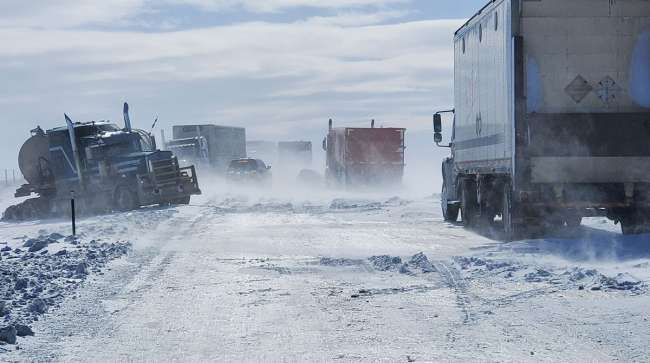Staff Reporter
Wyoming Helps Navigational Apps Improve Road Closure Data

[Stay on top of transportation news: Get TTNews in your inbox.]
Wyoming is sharing road closure data directly with Google and other navigation companies to save lives when Interstate 80 travelers find themselves stranded in bad weather after taking alternative routes on impassable roads, since some GPS systems rely on cellphone probes rather than actual road conditions.
The Wyoming Department of Transportation has expanded its sharing road-closure data with companies that provide navigation tools to improve safety and move freight, especially due to I-80 closures and the need for accurate motorist information during the critical months of March and April, which usually see the most snow.
When I-80 — one of the nation’s primary east-west highways — must be closed, that means conditions on the state’s rural secondary roads become even more dangerous, according to WYDOT.
“Last winter saw too many close calls, and we are excited to arrive at a practical solution that will keep both travelers and search-and-rescue responders safer,” WYDOT Director Darin Westby said. “WYDOT is constantly innovating and adapting to the challenges of Wyoming’s harsh winters and meeting our mission to keep people and commerce moving.”

Navigational apps generally report road closures and recommend alternative routes based on data collected from other drivers using the app, WYDOT notes. As a result, information about less traveled, local roads may be outdated about fast-changing road conditions.
“In Wyoming, some I-80 motorists following suggested detours have ended up stranded on inaccessible roads without fuel, food or water. This also creates hazards for the Wyoming Highway Patrol and other emergency responders tasked with finding and rescuing these motorists. Road closures and ill-advised detours during just one storm in 2023 resulted in 28 search-and-rescue missions in Sweetwater County alone,” WYDOT stated.

Garcia
Vince Garcia, who manages WYDOT’s geographic information system and intelligent transportation systems, said county roads often are unmaintained and may be impassable in the winter due to snow drifts.
“Navigation companies are typically going to be looking at cellphone probe data. They don’t really have the information about what’s happening on the roadway. The real source of information for that is truly WYDOT,” Garcia said.
Kandis Fritz, superintendent of Carbon County roads and bridges, said being stuck on an isolated rural road in the winter “can be very dangerous because we have below-freezing temperatures.”
The @WYDOTNews is widening access to #road closure data to help save lives in severe #weather situations. #travel #transportation #roadway #highway #mobility #snow #storm #blizzard @aashtospeaks @GovernorGordon @AAAnews @USDOTFHWA https://t.co/yoMwIp1n3O pic.twitter.com/J7VZVJElLO — Sean Kilcarr (@AASHTOsean) April 11, 2024
“You’re going to run out of fuel, you’re going run out of food,” she said. “There could be so many different scenarios that could happen, and we don’t want the worst for people.”
Sheila Foertsch, Wyoming Trucking Association president and CEO, said commercial vehicle drivers are given routes and told where to make deliveries but may be unaware of conditions between their starting and final destinations.
“We want to make sure that drivers have good information because they’re making those decisions and could wind up on a road that isn’t accessible, and they could be stranded there for hours,” Foertsch said. “Thinking they’re on a road that they’re going to be able to have a destination to and being trapped out there not know if they’d be able to have cell service or any kind of services available or when emergency vehicles could come get them is a huge concern for any driver, but a commercial vehicle driver with a big truck, that’s huge. That could be a matter of life or death.”
We want to make sure that drivers have good information because they’re making those decisions and could wind up on a road that isn’t accessible.
Wyoming Trucking Association CEO Sheila Foertsch
Image
To prevent such emergencies, WYDOT has expanded third-party access to a powerful tool called the Situation Data Exchange (SDX) and partnered with Laramie-based Trihydro, an engineering and environmental consulting firm. The SDX stores and distributes data collected from wirelessly connected vehicles, including WYDOT fleet vehicles and snowplows. WYDOT also consults with individual counties to include information on local and conditional closures. Now navigation companies having access to the SDX gain a new reliable source of real-time travel information, such as weather advisories, variable speed limits, road closure notifications and vehicle weight restrictions.
WYDOT began by reaching out to Google, which has entered into an agreement with Trihydro to be a third-party distributor of SDX data through Google Maps.
Eric Kolb, a senior staff data engineer at Google Maps, said, “The SDX provides Wyoming’s high-quality data in the desired format through a convenient interface, all of which reduces Google Maps’ effort to acquire and translate Wyoming’s road-incident updates into its navigation database. It’s been a pleasure working with the WYDOT and Trihydro teams to both understand and encourage their motivations and capabilities.”
WYDOT officials hope to finalize agreements with Apple and other navigation system providers in the near future. Also, WYDOT officials will continue coordinating with the U.S. Department of Transportation to expand access to the SDX.
Want more news? Listen to today's daily briefing below or go here for more info:





